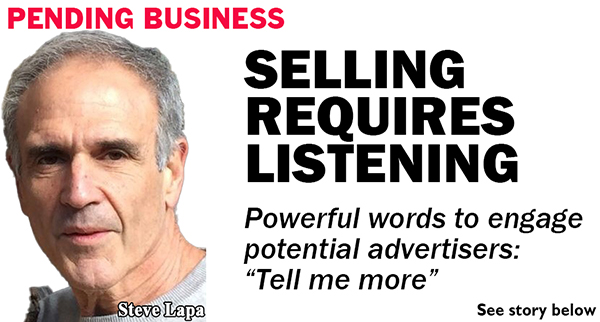Welcome to No-Brand Land!
By Gary Begin
Sound Advantage Media
 Broadcasting executives spend millions building their radio station’s brand in the marketplace. But is it being spent in the right place?
Broadcasting executives spend millions building their radio station’s brand in the marketplace. But is it being spent in the right place?
The frontline salesperson is a marketer’s greatest asset in creating brand justice and impact. But if you ask brand managers to look at their brand-building budgets, you’d probably see expenses allocated opposite to what drives brand purchase decisions.
Brand marketers continue to pump big bucks into extensive ad campaigns while doing next to nothing to deliver relevant, brand-supporting messages at the all-important, more significant level—the distance between a company’s sales voice and a prospect’s purchase decision.
What’s the answer?
It probably lies somewhere between (1) the unwillingness of radio stations and brand managers to go further “downstream” with their strategic recommendations and (2) the lack of useful tools to get them there.
Welcome to No Brand’s Land
Increasingly, a company’s branding success depends less on what they sell and more on how they sell it. Selected experts in branding seem to be coming around the idea that the power to make or break your brand-building effort lies not in the quality of your advertising but in the customer’s experience at the point of sale. In radio, that’s your over-the-air product and how your ad rep handles the advertiser.
On one side of No Brand’s Land, brand marketers can control all the implementation, ensuring the advertising campaign is right on, the media coverage generated by your on-air promotion is consistent, your Web site looks the same, and your corporate design is in place.
But on the other side of the No Brand’s Land, salespeople are still doing their own thing. They are cutting and pasting old proposals with outdated information and incorrect messages. They’re fabricating homegrown collateral tools and PowerPoint presentations that are, at best, inconsistent with corporate positioning or, worse, downright inaccurate.
The most frightening thing for brand marketers is that these cobbled-together documents must walk the halls of prospective customers, representing the company’s brand at the most critical points in the sales process. Ouch.
Adding insult to injury, the field-fabrication virus spreads exponentially as this lousy information is perpetuated across the channel on the brand’s intranet.
Crossing Over No Brand’s Land
To navigate and successfully cross No Brand’s Land effectively, marketers must start by adapting brand message creation and delivery to today’s strategic sales processes. Two trends will drive marketers’ efforts to create brand-supporting content that helps salespeople sell.
Trend #1: Value Selling
For more than a decade, sales training and methodology experts have focused on improving the consultative selling skills of salespeople—especially in complex selling environments. The concept is simple: first, salespeople identify customers’ needs; then, they demonstrate the ability of a solution to respond to that customer’s specific needs successfully.
Often called Value Selling or Solution Selling, this dynamic and interactive sales process replaces previously static, one-way techniques that debate the merits of competing features and functions.
While salespeople move toward creating a much more customized sales experience for each prospect, most marketing departments continue to deliver generic messaging using static collateral tools—a one-size-fits-all approach for a one-to-one world. No wonder salespeople are forced to scramble to create custom content, piecemealed from various sources, to demonstrate they have listened to the customer.
The first thing brand managers can do to help is translate their high-level positioning into street-ready value propositions and solution messaging that speak to customers the way salespeople have been trained to sell:
- Create customer empathy by identifying and demonstrating a proper understanding of the critical do-or-die issues facing your customers. Do that for each level of the decision-making team and link it back to how they do their jobs today.
- Next, determine and articulate the risks if they do not address these issues. Also, firmly establish and highlight the rewards if they do act. Take special care to find out how your customers will define success—determine what they want to brag about if they are successful in achieving positive results.
- Then demonstrate how your company’s solution helps them respond specifically—and successfully—to their key do-or-die issues.
Trend #2: Dynamic, Personalized Collateral Building
Value selling has raised the bar, forever changing customer expectations about sales experiences. Customers expect company interactions to be personal, relevant, and tailored to their specific needs.
Meanwhile, marketing departments have tried to keep pace by adopting segmentation strategies, doing their best to tailor messages and create more customer-relevant positioning. However, the tools to deliver these increasingly sophisticated messages through the sales channels have lagged. So, we’ve seen a proliferation of static collateral tools designed to fit every occasion.
Unfortunately, salespeople are neither warehouse managers nor librarians, and they have difficulty tracking and finding suitable materials when needed. In response, marketers have set up sales intranets to supply 24×7 access to support materials.
While these intranets improve accessibility to materials, they don’t resolve the most significant issue facing today’s value-selling salespeople: the need to provide prospects with dynamic, personalized sales communications. With only static documentation, salespeople begin creating unique, customized documents for each sales situation.
Typically, this happens at the expense of the brand and the company. The lack of consistency between radio stations and from salesperson to salesperson—undermines the millions spent on brand awareness advertising. The extra time spent by salespeople crafting these personalized proposals, presentations, and collateral pieces keeps them from time better spent with customers.
Marketing’s big win is that every radio salesperson, even within a multi-entertainment environment, will now communicate a consistent company message. Imagine the brand-building power unleashed when sales reps begin delivering a persuasive, powerful, and pre-approved message at every point of customer contact.
Gary Begin can be contacted at: garybegin10@gmail.com.






